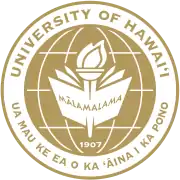Kapiʻolani Community College
University of Hawaiʻi Kapiʻolani Community College, formerly Kapiʻolani Technical School, is a public community college in Honolulu, Hawaiʻi. It is part of the University of Hawaiʻi system.
 | |
| Motto | Kūlia I Ka Nuʻu (Strive for the Highest) |
|---|---|
| Type | Public community college |
| Established | 1946 |
Parent institution | University of Hawaiʻi system |
Academic affiliations | Space-grant |
| Chancellor | Louise Pagotto |
| Students | 6,899[1] |
| Location | , , United States |
| Campus | Urban |
| Colors | Blue and White[2] |
| Website | kapiolani |
 | |
History
Originally located at Pensacola Street and Kapiʻolani Boulevard (from which the school gets its name), adjacent to President William McKinley High School in the Makiki community, University of Hawaii Kapiʻolani Community College was established in 1946 as Kapiʻolani Technical College. The school was administered by the Territory of Hawaiʻi as one of its chief vocational schools, specializing in food service. In 1965, its curricula was modified and became an open-door public college administered by the University of Hawaiʻi. As part of the realignment of programs, the school adopted its current name.
Expansion
Experiencing rapid growth in the 1970s, University of Hawaiʻi Kapiʻolani Community College needed larger facilities. In 1974, the Board of Regents acquired a 52-acre (210,000 m²) parcel of land on the slopes of Diamond Head in Waikīkī, formerly owned by the United States Army. University of Hawaiʻi Kapiʻolani Community College opened its second campus at Fort Ruger, the only college in the University of Hawaiʻi system to have two campuses of its own. The Board of Regents then agreed to move with a complete transfer of programs to the Fort Ruger campus and close the Makiki campus. University of Hawaiʻi Kapiʻolani Community College finally completed the transfer in the late 1980s.
Academics
University of Hawaiʻi Kapiʻolani Community College is the state's largest comprehensive community college with technical, occupational and professional programs in business education, food service and hospitality education, and nursing. It offers the state's most successful university transfer program as well as a well-respected STEM (Science, Technology, Engineering, and Mathematics) program. Nationally, University of Hawaiʻi Kapiʻolani Community College has been recognized for its programs in health sciences and education for emergency medical services. Locally, KCC is well known for its culinary program. Other students attend University of Hawaiʻi Kapiʻolani Community College as a starting point before moving on to the University of Hawaiʻi at Mānoa and other four-year universities to complete a bachelor's degree.
Of all the community colleges in the University of Hawaiʻi System, KCC has the largest liberal arts student body with over 6,000 students enrolled annually. Some of the most popular majors for students transferring from KCC to universities are Business, Nursing, Art, Psychology, English, Biology and Pre-Med. The campus has one of the nation's largest international student bodies and attracts students from over 100 nations including very large numbers of students from Japan, Korea, China and Hong Kong because of its programs of study, links to the University of Hawaii - Mānoa, and proximity to Waikīkī. It is also a leading community college campus in Hawaii for business education programs such as information technology, accounting and marketing.
Points of interest
- University of Hawaiʻi Kapiʻolani Community College Cactus Garden
Campus art includes:
- Spirit Way, bronze sculpture by Sean K. L. Browne, 1987
- Pohaku O Leahi, ceramic sculpture with water feature by Lucille B. Cooper, 1994
- Hawaii, Hawaii, faceted glass mural by Erica Karawina, 1988
- Mai Ka Mea Hana Ka ʻIke (From Tools, Comes Knowledge), basalt sculpture by Mark Watson, 1988
- Sol III, fiberglass and steel sculpture by Mamoru Sato, 1973